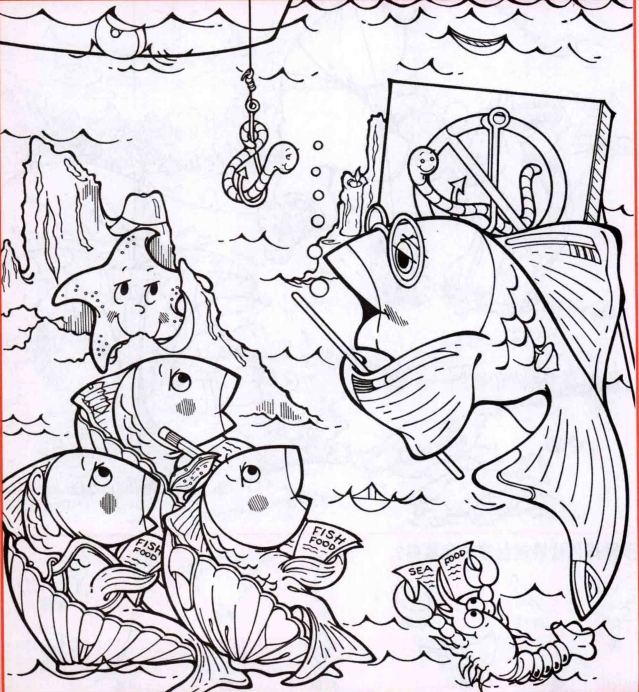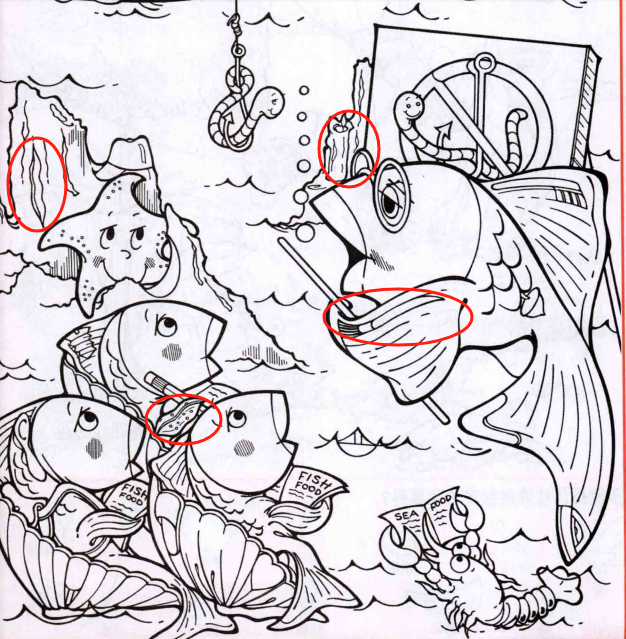Dive into the Underwater Classroom: Fish Learning Fish Nutrition
Exploring the Concept of Marine Education
Have you ever imagined what a school looks like beneath the waves? In this delightful illustration, a wise, spectacled fish stands at a chalkboard, pointer in fin, while a trio of eager young fish—each nestled in its own scallop-shell seat—holds lesson pamphlets titled “Fish Food.” A curious starfish lurks nearby, and a friendly crab waves a “Sea Food” flyer. Even a wriggly worm dangles from a fishing line as a real-world demonstration piece. This whimsical scene captures the magic of marine education, reminding us that learning isn’t confined to classrooms on land—underwater creatures benefit from guidance too.

The Importance of Fish Nutrition and Healthy Diets
Just like humans, fish require balanced diets to grow, stay healthy, and thrive in their environments. In aquaculture and home aquariums alike, understanding fish nutrition is critical:
- Protein Needs: Many fish need high-quality protein from pellets, live foods, or insect larvae to build muscle and repair tissues.
- Essential Fatty Acids: Omega-3 and omega-6 fatty acids support immune function and vibrant coloration.
- Vitamins and Minerals: Vitamins A, D, E, K, and minerals like calcium and phosphorus ensure strong bones, clear vision, and metabolic health.
- Diet Diversity: A varied menu—flakes, pellets, frozen brine shrimp, algae wafers—prevents nutritional gaps and keeps feeding time exciting.
Our fish teacher uses a pointer to emphasize these nutrients on a seabed chalkboard, illustrating how undersea schooling mirrors our own emphasis on balanced meals, vitamins, and healthy habits.

Setting Up an Aquarium “Classroom” for Your Fish
Want to give your aquatic friends a healthy education? Transform part of your aquarium into a teaching zone:
- Install a Feeding Station: Use a transparent feeding ring or small flat rock where you place varied foods—flake mix, spirulina wafers, live daphnia—so fish learn to associate it with mealtime.
- Create Visual Cues: Attach bright stickers or magnets on the tank wall above the feeding area to signal “class in session.” Over time, your fish recognize the spot and congregate there.
- Label Food Containers: Just like our mermaid-tailed pupils reading “Fish Food,” organize your pantry with clear labels: “Protein Pellets,” “Veggie Wafers,” “Frozen Treats.”
- Rotate the Menu: Offer different foods on a schedule—Monday: pellets; Wednesday: brine shrimp; Friday: blanched spinach—so your fish never get bored.
By mimicking the structured, playful approach of our underwater classroom, you’ll keep your finned students engaged and well-nourished.
Behavioral Enrichment: Beyond Basic Feeding
Feeding time becomes more than mere sustenance; it’s an opportunity for mental stimulation—just like our crab waving “Sea Food” leaflets to grab attention. Consider these enrichment strategies:
- Puzzle Feeders: Hide pellets in floating rings or mesh bags that require fish to nudge and forage, encouraging natural hunting behaviors.
- Live Plant Lessons: Introduce live aquatic plants—Java fern, Anubias, Vallisneria—that fish nibble at or use for shelter, offering both nutrition and environment enrichment.
- Target Training: Train fish to follow a colored stick or laser pointer. Reward with a small flake for each correct follow-through, simulating our worm-on-a-hook demonstration.
- Mirror Reflections: Place a small mirror outside the tank briefly to encourage bubble-blowing and playful chirping, teaching social interaction.
These activities turn your aquarium into a dynamic “school” where fish learn, play, and thrive.

Lessons from the Sea: What Humans Can Learn
The underwater classroom teaches us valuable human lessons:
- Scheduled Meals Promote Routine: Just as our fish pupils know when to gather for “class,” humans flourish on regular meal times for metabolism and mood stability.
- Diet Variety Prevents Nutrient Deficiencies: Rotating different food groups keeps the diet balanced—whether under the sea or at your dining table.
- Enrichment Reduces Boredom: Stimulating activities improve mental health—compare a fish puzzle feeder to a human hobby like gardening or painting.
- Social Feeding Builds Community: Shared meals foster bonds, from fish schooling together at feeding rings to families cooking and eating together.
By observing how our aquatic friends learn and eat, we gain fresh perspectives on healthy habits, routine, and the joy of shared learning.

Designing Educational Aquariums for Public Spaces
Museums, schools, and community centers can create captivating educational exhibits inspired by this scene:
- Interactive Tank Displays: Equip aquariums with buttons that trigger themed feeding times—“Protein Pellets at 10 AM!”—and show real-time videos of fish gathering.
- Augmented Reality Learning: Use AR apps that overlay nutritional information onto live tank images, teaching visitors about each species’ diet.
- Storyboards & Signage: Frame large, whimsical illustrations of fish teachers and students, complete with speech bubbles explaining feeding facts.
- Hands-On Workshops: Offer “Feed the Fish” sessions where participants rotate between different food stations—brine shrimp, flakes, plant matter—learning what each fish species prefers.
Such immersive experiences echo our illustrated lesson, sparking curiosity in marine biology and responsible pet care.

Conclusion: Embracing Underwater Learning for Healthier Habits
Our charming undersea classroom—where a fish professor lectures mermaid-tailed pupils on fish food, starfish, and wriggling worms—does more than entertain. It mirrors essential truths about balanced nutrition, routine, enrichment, and community bonding. By adopting these principles in home aquariums, human meal planning, and public education venues, we bridge the gap between oceanic wonder and everyday well-being. So next time you feed your finned friends, imagine them as eager students, absorbing lessons that keep them—and us—growing strong and happy beneath the waves and beyond.





